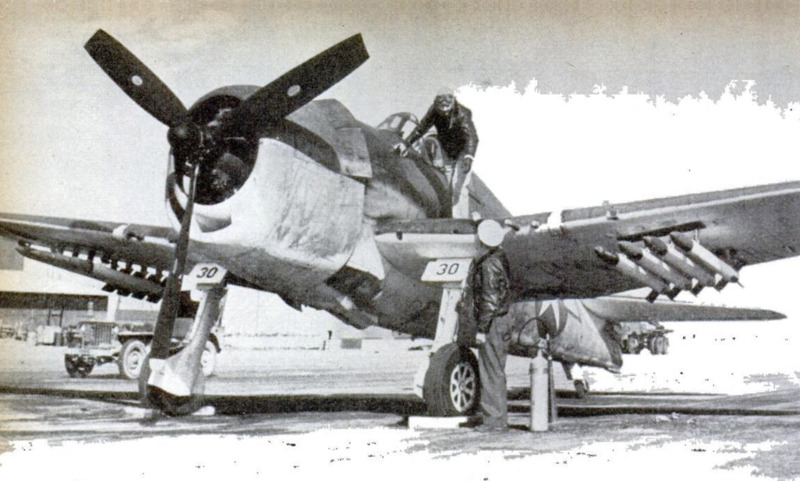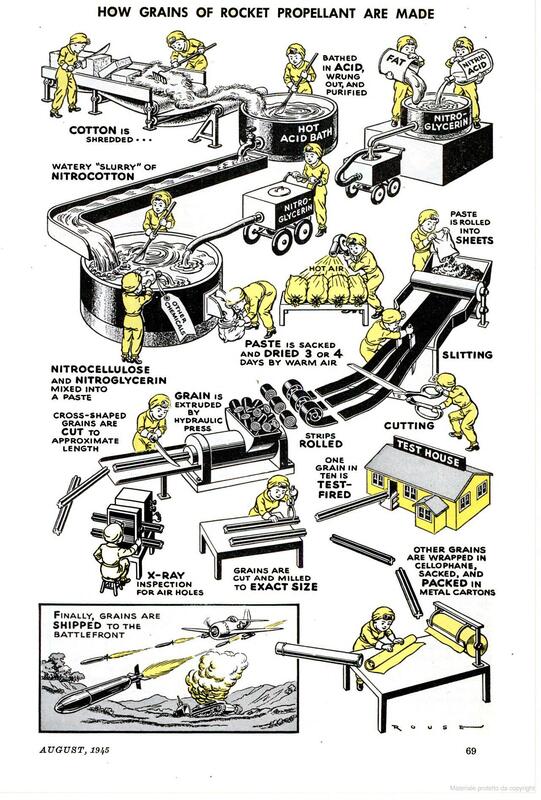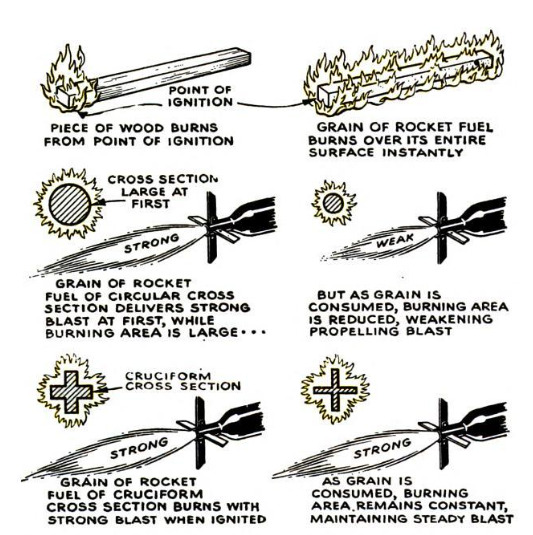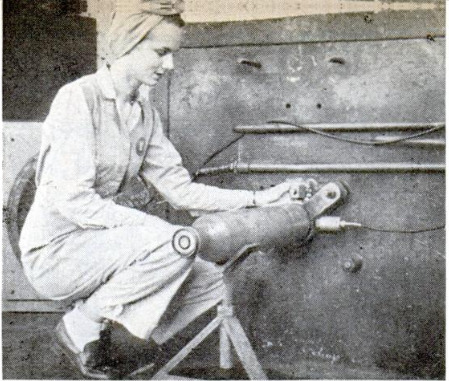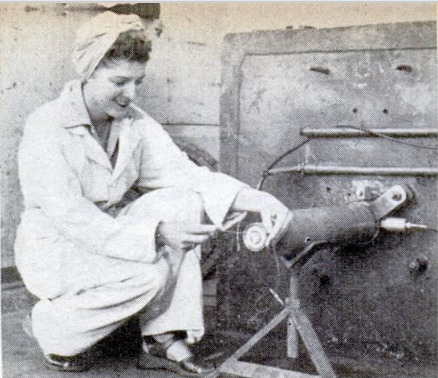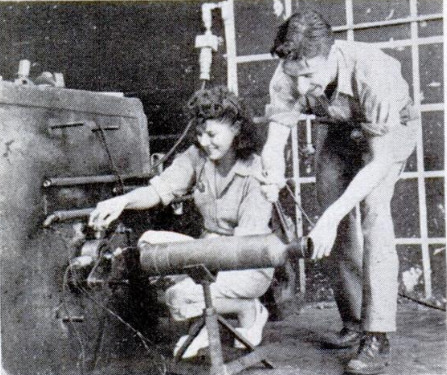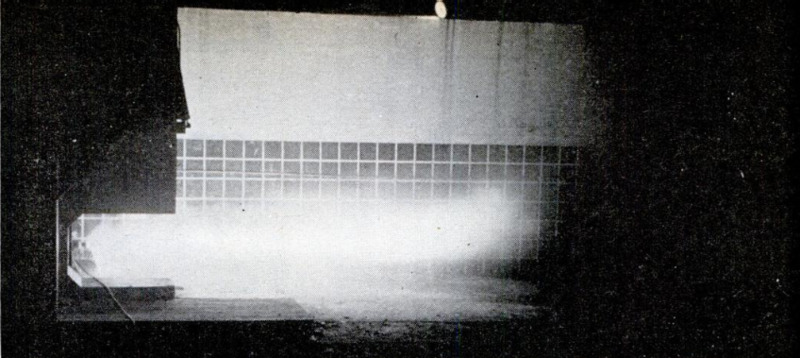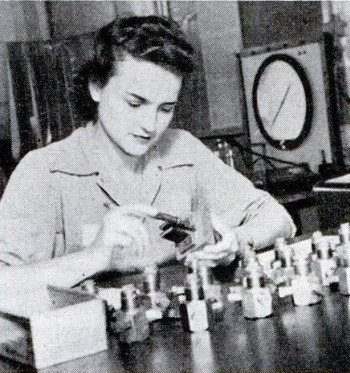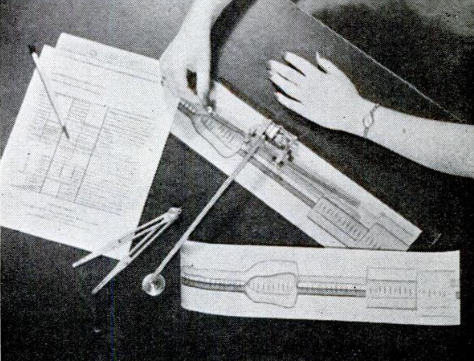-
Title (Dublin Core)
-
What makes the rocket go
-
Article Title and/or Image Caption (Dublin Core)
-
What makes the rocket go
-
extracted text (Extract Text)
-
THE newest tool of war is a self-
driven arrow—a long, thick,
black, 12-sided rod that looks as
though it were made out of hard |
rubber. A child or a chemist
might quickly suspect that it was |
a secret weapon. But an ordinary |
fellow, seeing one of these oddly
shaped clubs for the first time,
has to wipe a look of incredulity
off his face when told that it is a
stick of concentrated zoom that
already has revolutionized war-
fare. |
These solid bars of chemical
energy are the innards of rocket
motors. They are made out of |
cotton and fat. Fach one has the
power, when put in a light tube |
and set on fire, to hurl itself and a
war head into the enemy's midst |
by consuming itself. This method |
of pulverizing opposition has been
so effective that America’s facili-
ties for manufacturing these flam- |
ing arrows still were being en- |
larged after production of other matériel
was allowed to taper off.
Until now, the story behind the nation's
investment of $1,350,000,000 in rockets this
year—four times as much as in 1944—could
not be rounded up and told out loud, Rockets
are seven centuries old, but, until three
years ago, no American company manufac-
tured military rocket powder, and these big,
black bars are so new that all information
about them has been highly confidential.
Tens of thousands of men and women now
are making these twentieth-century arrows
in colossal plants such as the U. S. Army
Ordnance Works operated by the Hercules
Powder Co., at Sunflower, Kan., Radford,
Va., and Badger, Wis. These war workers
mix, move, squeeze, chop, and test extreme-
ly explosive and inflammable materials;
6,000 fires broke out in one month in one
plant. But the work has been 50 surrounded
by modern safeguards that fewer people
were hurt in these plants last year than in
any other American industry.
Technically, each big, self-driven arrow
is a single grain of a double-base solvent-
less gunpowder. The safe mass production
of such gigantic grains is an industrial
achievement that was made possible by
know-how acquired from the British in 1942,
plus the intensive research of many Ameri-
can ordnance men and powder chemists.
A grain of ordinary gunpowder (P.S.M.,
May ‘44, p. 128) is usually a perforated
cylinder up to an inch in diameter and rare-
ly more than two inches long. But these
new rocket-powder grains are solid, shaped
like a cross rather than round, four inches
thick, and from three to five feet long. A
five-foot grain weighs about 40 pounds and
is the equivalent in weight of about 13,600,
000 grains of .30 caliber rifle powder.
Double-base powders were developed half
a century ago, but the world was slow to
perceive their potentialities as rocket-push-
ers. These particular grains are about half
nitrocellulose, which is made from cotton
or wood, and about half nitroglycerin, which
is made from fat such as housewives save.
Both nitrocellulose and nitroglycerin are
high explosives, used in making dynamite.
But, with the help of other chemicals, they
now are being united in such a way that a
compound is made that burns instead of ex-
ploding.
The first rockets fired in this war con-
tained solvent powder. which was consid-
ered safer to produce than solventless pow-
der. It is still being used in many rockets,
but it cannot be formed into such gigantic
grains as are now being turned out. Thirty
grains of solvent powder are needed to pro-
pel one 4.5-inch rocket, and they must be
held in place by a wire framework inside
the tube. With the mew solventless pow-
der, a single grain can be made big enough
to fill an even bigger rocket. No wire frame-
‘work is needed and the casing can be light-
er. Weight is saved, and the rocket’s pow-
er is increased.
With big, single, solid chunks of fuel,
rockets also are being made more accurate.
This accounts for the peculiar shape of the
fiery arrows. A rocket is driven by the re-
action to the ejection of gas from its tail.
The speed and smoothness of its flight are
determined by the velocity and steadiness
of that jet. If the fuel does not ignite
quickly, the rocket gets off to a slow start.
And if the fuel burns unevenly, creating
gobs of gas rather than a steady flow, the
motion given to the rocket is irregular.
These new rods of American-made pro-
pellant powder do not burn like a candle or
a stick of wood, from one end to the other.
Instead, when they are ignited at any point,
the whole surface of the fuel begins to burn.
The constancy of the combustion, conse-
quently, is determined by the size of the
burning surface.
Suppose, for a moment, that the big
grains were round. The amount of burn-
ing surface then would decline as the fuel
was consumed, less and less gas would be
given off, and the rocket would lose speed.
The grain might, of course, be hollow. The
flames eating outward would then enlarge
the burning surface, more gas would be cre-
ated, and the jet's power would increase.
But a con-
stant thrust is preferable. So the grain
has been made solid, but shaped so that the
burning surface grows smaller less rapidly
than the fuel is consumed. A cross section
of one of these arrows resembles a cross, or
plus mark, because this shape contributes
to the steadiness of the jet and thus increases
a rocket battalion's chances of demolishing
a small, distant target.
The sensitivity of the chemical com-
pound in these arrows is so great that the
rocket's performance may even be affected
materially by the weather. On a warm day,
the fuel begins to burn so much more quick-
ly than on a cold day that the acceleration
of the rocket is appreciably greater.
A tiny air hole or defect in the texture of
the arrow may cause it to explode rather
than burn steadily. In that case, our own
men may be killed. And even a minute
irregularity in the surface of the arrow may
cause the rocket to swing and sway in its
flight and fall to earth far from the target.
Each of these arrows, therefore, is a pre-
cision job. About 40 different inspections
are made during the manufacturing pro-
cess. Every arrow is X-rayed to determine
the homogeneity of the material. The whole
surface of each arrow sent to the front is
within one thousandth of an inch of the
specified dimensions. And every tenth ar-
row completed is test-fired.
The ordnance plants where these arrows
are made cover many square miles, because
each important step in the manufacturing
must take place in a separate building.
Many of these buildings are air-conditioned
and heavily barricaded. Nozzles of the
world’s fastest automatic-sprinkler system
surround the machinery where the tricky
ingredients are mixed, and the workers wear
flameproof uniforms, and safety shoes,
gloves, and masks.
The nitrocellulose used in these arrows
could be made anywhere and shipped to the
rocket-powder plant. But it is made right
there, so that the manufacturers can con-
trol the whole process rigidly. Nitroglycerin
is 50 unstable that shipping it far would be
dangerous. So it, too, is produced in the
rocket works and cautiously moved to the
point where it is mixed with the nitrocel-
lulose in rubber-tired handcarts.
When mixed, this witches’ brew is a
paste, which is rolled out in a long, black
carpet. Like wild-animal trainers, the girls
who handle the paste never turn their backs
or take their eyes off the tricky stuff. And
the operators step out wide the building
while the machines do the most dangerous
part of the work.
“The big carpet is cut into strips and rolled
into bundies. These resemble jelly rolls, but
have the sickeningly sweet odor of dyna-
mite. They are dried and placed in a hy-
draulic press, which squeezes them under &
pressure of 5,000 pounds per square inch |
into long, cruciform rods.
This press is operated from a control
panel outside a barricaded building, but
the operator re-enters the bullding after n |
rod has been extruded and slices it nto
arrows of the required length with & guillo-
tine knife. Others then inspect and mil each
arrow, and shove It Into A lead box to be
scrutinized by X rays.
“The arrows chosen for test-fring are re-
moved to loading rooms, where the tempera-
ture and humidity are so controlled as to |
simulate the atmospheric conditions in
Which the rockets will be used. Each ar.
row 1s baited to a concrete block, to prevent
it from hurling itself through the air, but
its power is ascertained by gauges and
photographs.
Inside each gauge there are a tiny ham-
mer, anvil, and copper ball. The jet from |
the test arrow hurls the hammer against
the ball. Operators then remove the ball |
from the gauge and measure the amount
that It has been compressed.
The jt ia also photographed indirectly
with a rotating-drum camera that records
the deflection of light from mirrors attached
to galvanometers. The picture obtained is
actually a bell-shaped chart that shows how
many hundredths of a second the fuel
burned, how quickly the gas pressure rose, |
how steady this pressure was, and how ff |
tapered off.
But what use will the world have for such
self-driven arrows in peacetime? Hercules
Powder Company spokesmen see no reason
why such a propellant cannot be used to
whisk heavily loaded airplanes off the |
ground. Twenty percent greater cargoes
could be carried with such takeoffs
-
Contributor (Dublin Core)
-
Volta Torrey (article writer)
-
Language (Dublin Core)
-
eng
-
Date Issued (Dublin Core)
-
1945-08
-
pages (Bibliographic Ontology)
-
68-71,214
-
Rights (Dublin Core)
-
Public domain
-
Archived by (Dublin Core)
-
Sami Akbiyik
-
Marco Bortolami (editor)
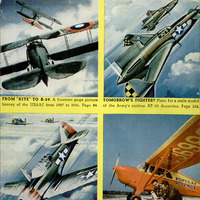 Popular Science Monthly, v. 147, n. 2, 1945
Popular Science Monthly, v. 147, n. 2, 1945

